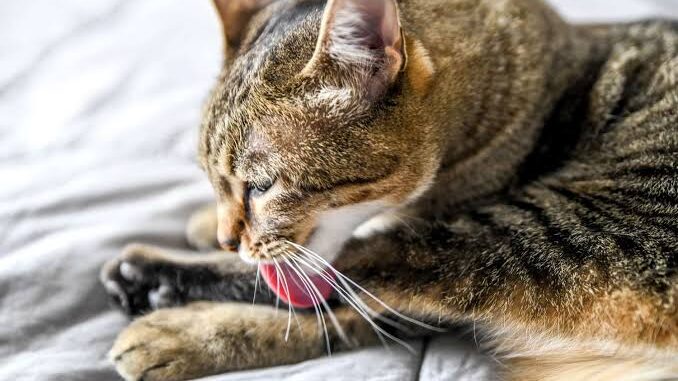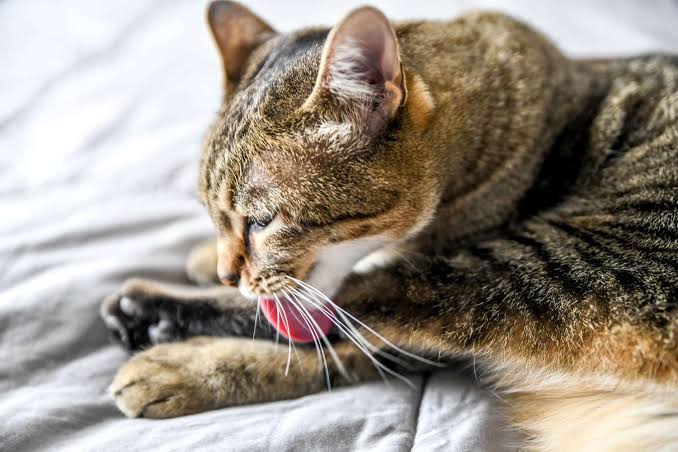
Why Cats Groom Themselves and When to Intervene: Cats are known for their cleanliness. Unlike many animals, felines spend a significant portion of their waking hours grooming themselves. While this behavior is normal and healthy in most cases, there are times when it can signal underlying issues that require human intervention.

Understanding why cats groom, what’s considered normal, and when it becomes a problem can help you better care for your feline companion.
Why Cats Groom Themselves
1. Hygiene and Cleanliness
The primary reason cats groom themselves is to maintain hygiene. Their rough tongues, covered in tiny hook-like structures called papillae, are perfect for cleaning fur, removing dirt, loose hair, and parasites. This grooming helps keep their coat in pristine condition.
2. Temperature Regulation
Cats do not sweat like humans. Instead, grooming helps them stay cool. When a cat licks its fur, the saliva evaporates and creates a cooling effect, especially on hot days.
3. Stimulating Blood Flow
The action of licking stimulates blood circulation to the skin and fur. This not only improves coat health but also helps distribute natural skin oils evenly, which keeps their fur glossy and water-resistant.
4. Comfort and Stress Relief
Grooming is also a soothing behavior. Cats often groom after stressful situations—like a vet visit or a loud noise. It’s a self-soothing mechanism, akin to humans biting nails or fidgeting.
5. Bonding Behavior
Cats groom each other—a behavior called allogrooming—to reinforce social bonds. If your cat licks you, it’s a sign of affection and trust. Mutual grooming among cats, especially those that live together, shows they are part of the same social group.
6. Removing Loose Fur
Cats shed fur year-round. Grooming helps manage shedding by removing loose hair. This is also why you may find hairballs around the house—these are the result of swallowed fur during grooming.
What’s Considered Normal Grooming?
Cats typically spend 30–50% of their waking hours grooming themselves. Normal grooming is:
- Periodic throughout the day
- Focused across different areas (face, ears, back, legs, tail)
- Done in a relaxed manner
- Doesn’t cause bald spots, redness, or irritation
Short bursts of grooming after meals, naps, or play are also common.
When Grooming Becomes a Problem
While grooming is essential, overgrooming or undergrooming can indicate an issue.
1. Overgrooming (Excessive Grooming)
Signs:
- Bald patches or thinning fur
- Red, irritated, or broken skin
- Frequent vomiting due to hairballs
- Constant licking, chewing, or biting
Causes:
- Allergies: Food, pollen, dust, or flea saliva can make cats itchy.
- Parasites: Fleas, mites, and ticks cause intense itchiness.
- Pain: Cats may lick a painful area (like a sore joint or injury).
- Stress or Anxiety: A new pet, move, or change in routine can trigger compulsive grooming.
- Boredom: Cats left alone for long periods may develop habits like overgrooming as a coping mechanism.
- Skin Conditions: Fungal infections, dermatitis, or acne can also be culprits.
2. Undergrooming (Insufficient Grooming)
Signs:
- Greasy, matted, or dull coat
- Foul odor
- Fecal matter or dirt clinging to fur
- Increased dandruff
Causes:
- Obesity: Overweight cats struggle to reach certain parts of their bodies.
- Arthritis or Pain: Elderly cats with joint pain may avoid grooming due to discomfort.
- Dental Issues: Painful teeth or gums can discourage grooming.
- Neurological Conditions: These may impair the cat’s ability to groom.
- Depression or Illness: Lethargy from illness or emotional distress reduces grooming interest.
READ ALSO: How to Keep Your Dog Cool During Hot Summer Days
When and How to Intervene
1. Monitor Behavior
Keep an eye on your cat’s grooming patterns. A sudden increase or decrease in grooming is a red flag. Document changes and discuss them with your vet if they persist.
2. Check the Coat and Skin
Examine your cat’s skin for redness, scabs, dandruff, bald spots, or parasites. Look closely at areas cats can easily reach—like their belly or legs.
3. Address Underlying Causes
If a health issue is suspected, a vet visit is essential. Blood work, allergy testing, skin scrapings, or behavioral assessments might be necessary to determine the cause.
4. Environmental Enrichment
To reduce stress or boredom, try:
- Cat trees and perches
- Interactive toys
- Regular playtime
- Calming pheromone diffusers
- Scheduled feeding and routines
5. Dietary Adjustments
High-quality food improves coat condition and reduces shedding. Omega-3 and omega-6 fatty acids promote skin health. Special diets may be prescribed for allergies.
6. Grooming Support
Cats may need help grooming, especially if elderly or overweight:
- Brush regularly to prevent mats and hairballs
- Wipe the fur with pet-safe grooming wipes
- Trim long fur near the rear for cleanliness
- Use flea treatments as recommended
7. Behavioral Intervention
In compulsive groomers, the behavior can become addictive. Behavioral therapy, medication, or stress-reduction strategies may be needed. Involve your vet or a veterinary behaviorist.
FAQs
How often should I groom my cat myself?
It depends on the breed:
- Short-haired cats: Once a week
- Long-haired cats: Daily or every other day
Grooming reduces shedding and the formation of hairballs.
Are hairballs dangerous?
Occasional hairballs are normal. However, frequent vomiting, gagging without producing a hairball, or signs of constipation could indicate a blockage, which is a medical emergency.
Why does my cat groom right after I pet them?
This behavior is often seen as a way to “reset” their scent or reduce overstimulation. Some cats enjoy petting but become overly sensitive quickly, prompting self-grooming.
Can grooming be a sign of affection toward humans?
Yes. If your cat licks your skin, hair, or even clothes, it could be a sign of bonding. They view you as part of their social group, much like they groom fellow cats.
How do I stop my cat from overgrooming?
First, identify the root cause—medical or behavioral. Once diagnosed:
- Treat infections or parasites
- Address allergies
- Reduce stress (e.g., with environmental enrichment)
- In some cases, medications like anti-anxiety drugs may be prescribed
Never punish your cat—it can make the issue worse.
My cat has stopped grooming completely. What should I do?
This is a serious sign and usually points to pain, obesity, or illness. Consult your vet immediately. Lack of grooming often accompanies other signs like weight changes or lethargy.
Why does my elderly cat’s coat look greasy and unkempt?
Aging cats often suffer from arthritis, reduced mobility, or dental problems—all of which interfere with grooming. Regular vet checkups and assisted grooming can help.
Is it normal for cats to groom other pets?
Yes. Cats that are bonded with dogs, other cats, or even humans may engage in grooming as a social bonding behavior. However, grooming aggression (sudden biting after licking) should be monitored.
What are the best grooming tools for cats?
- Slicker brushes: Good for all coat types
- Rubber grooming mitts: Ideal for short-haired cats
- Metal combs: Helpful for detangling long fur
- Deshedding tools: Remove loose undercoat hair (e.g., Furminator)
Can cats groom too much after a vet visit?
Yes. This is usually stress-related. Cats may also lick the area where they received injections. Monitor the area to ensure it doesn’t become inflamed or infected.
Leave a Reply
You must be logged in to post a comment.